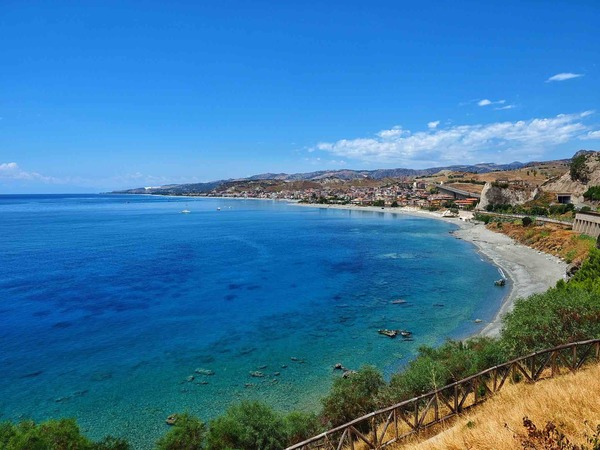

View of the Bovese landscape, looking south from the Bova Castle. Photograph by Meredith Chesson. July 2015.
Professors W. Martin Bloomer (Classics), Meredith Chesson (Anthropology), and Charles Leavitt IV (Romance Languages and Literatures-Italian), faculty affiliates of the Center for Italian Studies, have received a grant from the Nanovic Institute for European Studies to pursue a project entitled "Place, Memory, Story in Contemporary Calabria: An Interdisciplinary Approach to the Recuperation of Heritage."
For the project, they are planning a series of visits and workshops to explore how rural Calabrians in and around the municipality of Bova valorize their cultural heritage, including minority languages, rural landscapes, and architecture, in order to sustain their communities socially and economically.

View of Bova Marina. Photograph by Isaac Ullah. July 2017.
Bovese cultural heritage resonates with a long history of emigration. The near loss of minority languages, the abandonment of villages in the face of social, economic, and political change, the emigration of young people in particular have driven a desire to recover and transmit Bovese cultural heritage. Emigration also threatened individual and national identities for those who remained in the Bovese region, though in admittedly different ways than for those who left. This multidisciplinary research investigates how Bovese use their tangible and intangible heritage resources to build their present and future. Furthermore, the Bovese case study shares many common elements with other rural communities throughout Europe, in which inhabitants of rural villages and towns currently (and in the past) confront tremendous logistical, economic, and social challenges as people abandon the rural life for urban economic opportunities and lifestyles.
This case study offers both prescriptions and proscriptions for considering how rural communities throughout the European Union can marshal their heritage resources to build a future for themselves as members of the EU. Lastly, this research into modern Bovese communities in southern Calabria seeks to offer current residents appropriate scholarly tools to contribute to the construction of their own heritage and sense of local and national identity. This research resonates powerfully with contemporary Bovese residents because it offers them a sense of where they came from and undeniable proof of their resiliency, validity, and future potential to survive in a rapidly changing world which is particularly threatened by emigration of younger people away from their rural homes.